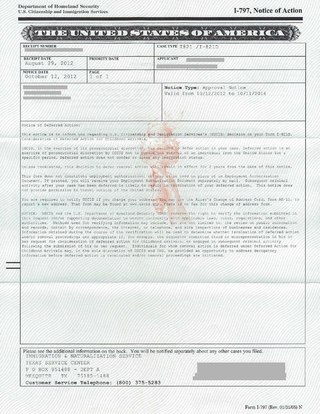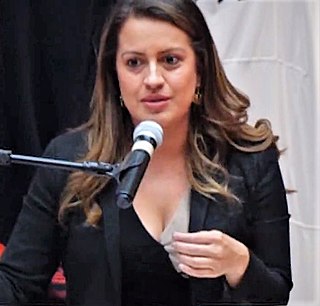American Apparel Inc. is a North American clothing retailer. The brand began with operating retail stores between the late 1980s and late 2010s. Its operations are based in Los Angeles, California. Founded by Canadian businessman Dov Charney in 1989, it was a vertically integrated company that ranked as one of the largest apparel manufacturers and marketers in North America.

The Development, Relief, and Education for Alien Minors Act, known as the DREAM Act, is a United States legislative proposal to grant temporary conditional residency, with the right to work, to illegal immigrants who entered the United States as minors—and, if they later satisfy further qualifications, they would attain permanent residency.
Malaquías Montoya is an American-born Chicano poster artist who is known as a major figure in the Chicano Art Movement of the 1960s and 1970s.

Jose Antonio Vargas is a journalist, filmmaker, and immigration rights activist. Born in the Philippines and raised in the United States from the age of twelve, he was part of The Washington Post team that won the Pulitzer Prize for Breaking News Reporting in 2008 for coverage of the Virginia Tech shooting online and in print. Vargas has also worked for the San Francisco Chronicle, the Philadelphia Daily News, and The Huffington Post. He wrote, produced, and directed the autobiographical 2013 film Documented, which CNN Films broadcast in June 2014.

JR is the pseudonym of a French photographer and street artist. JR stands for the initials of JR's first name, which is Jean-René.
The Trail of Dreams in 2010 was a 1,500-mile (2,400 km) walk from Miami, Florida to Washington, D.C., created by four students to support the passing of the DREAM Act. The act proposed federal legislation that would provide conditional resident status to undocumented immigrant students of good moral character. Inspiration for the name "Trail of Dreams" came from the Trail of Tears.

This Man is a mysterious individual who has purportedly appeared in the dreams of numerous people since 2006, yet his real-world identity remains unknown. In 2008, Italian sociologist and marketer Andrea Natella created a website called Ever Dream This Man? that focused on this phenomenon. According to the website, the first individual to report dreaming about This Man was a patient of a psychiatrist in New York City in 2006, and four other patients of the same psychiatrist also recognized the same face. The website received over 8,000 accounts from people who claimed to have encountered This Man in their dreams, sharing their stories and drawings. Various theories were proposed to explain This Man's appearance, ranging from mundane to supernatural, but none were substantiated by evidence or investigation. The website gained attention from the press and online users in October 2009 and became a viral sensation. This Man's notoriety spawned several internet memes that spoofed flyers of the website, references in films and television shows like The X-Files, and a manga series by Weekly Shonen Magazine. It eventually came out that This Man was a hoax, and was actually a guerrilla marketing campaign by Natella's advertising agency. Natella admitted that he had fabricated the whole story and that he had based the original sketch of This Man on a photo of his father when he was young. Natella said that he was inspired by the concept of dream invasion, which he had encountered in some movies and books, and that he wanted to explore the power of the internet to create and spread urban legends and collective myths.

Deferred Action for Childhood Arrivals, colloquially referred to as DACA, is a United States immigration policy that allows some individuals with unlawful presence in the United States after being brought to the country as children to receive a renewable two-year period of deferred action from deportation and become eligible for an employment authorization document in the U.S. To be eligible for the program, recipients cannot have felonies or serious misdemeanors on their records. Unlike the proposed DREAM Act, DACA does not provide a path to citizenship for recipients. The policy, an executive branch memorandum, was announced by President Barack Obama on June 15, 2012. This followed a campaign by immigrants, advocates and supporters which employed a range of tactics. U.S. Citizenship and Immigration Services (USCIS) began accepting applications for the program on August 15, 2012.

Yosimar Reyes is a Mexican-born poet and activist. He is a queer undocumented immigrant who was born in Guerrero, Mexico, and raised in East San Jose, California. Reyes has been described as "a voice that shines light on the issues affecting queer immigrants in the U.S. and throughout the world."
Undocumented youth in the United States are young people living in the United States without U.S. citizenship or other legal immigration status. An estimated 1.1 million undocumented minors resided in the U.S. as of 2010, making up 16% of the undocumented population of 11 million. Undocumented students face unique legal uncertainties and limitations within the United States educational system. They are sometimes called the 1.5 generation, as they have spent a majority of their lives in the United States.

Prerna Lal is a United States citizen, born and raised in Fiji Islands with roots in the San Francisco Bay Area. Lal is a founder of DreamActivist, an online advocacy network led by undocumented youth. Through the use of social media, they have been credited for organising an online network to stop the deportations of undocumented youth and they are well known as one of the pivotal figures and leaders of the DREAM Act movement. A former clinical law professor, Lal is a frequent writer on immigration, racial justice, sexual orientation, and how these forces intersect. Lal is a graduate of The George Washington University Law School, and works as an immigration attorney.

The AIDS pandemic began in the early 1980s and brought with it a surge of emotions from the public: they were afraid, angry, fearful and defiant. The arrival of AIDS also brought with it a condemnation of the LGBT community. These emotions, along with the view on the LGBT community, paved the way for a new generation of artists. Artists involved in AIDS activist organizations had the ideology that while art could never save lives as science could, it may be able to deliver a message. Art of the AIDS crisis typically sought to make a sociopolitical statement, stress the medical impact of the disease, or express feelings of longing and loss. The ideologies were present in conceptions of art in the 1980s and are still pertinent to reception of art today as well. Elizabeth Taylor, for example, spoke at a benefit for AIDS involving artwork, emphasizing its importance to activism in that "art lives on forever". This comment articulates the ability of artwork from this time to teach and impact contemporary audiences, post-crisis. This page examines the efforts of artists, art collectives, and art movements to make sense of such an urgent pandemic in American society.

Isa Noyola is a Latina transgender activist, national leader in the LGBT immigrant rights movement, and deputy director at the Transgender Law Center. In 2015, she organized the first national trans anti-violence protest. This protest was an event that brought together over 100 activists, mostly trans women of color, to address the epidemic of violence trans communities face, especially as race and gender intersectionality relates to immigration and incarceration as they deal with transphobic systems.
Forbidden: Undocumented and Queer in Rural America is a 2016 documentary about Moises Serrano, who grew up queer and undocumented in Yadkinville, North Carolina. Produced by director Tiffany Rhynard and editor Heather Mathews, the immigration reform documentary had its world premiere in Los Angeles at Outfest on July 12, 2016.
Filipino American LGBT Studies is a field of studies that focus on the issues met by people at the intersection of Filipino American and lesbian, gay, bisexual, and transgender identities.
Jaime Cortez is a Chicano-American graphic novelist, visual artist, writer, teacher, and performer. Cortez is also known for his role as an LGBT rights activist, and HIV/AIDS prevention work.

Catalina Cruz is a Colombian-American attorney from the borough of Queens in New York City. A member of the Democratic Party and former undocumented immigrant minor (DREAMer), Cruz has worked as an advocate for immigration rights, including as Director of New York Governor Andrew Cuomo's 2016 Exploited Task Force. Cruz was elected as the Democratic candidate in the Fall 2018 election for the 39th district of the New York State Assembly, representing Corona, Elmhurst, and Jackson Heights, Queens.
Queer art, also known as LGBT+ art or queer aesthetics, broadly refers to modern and contemporary visual art practices that draw on lesbian, gay, bisexual, transgender, and various non-heterosexual, non-cisgender imagery and issues. While by definition there can be no singular "queer art", contemporary artists who identify their practices as queer often call upon "utopian and dystopian alternatives to the ordinary, adopt outlaw stances, embrace criminality and opacity, and forge unprecedented kinships and relationships." Queer art is also occasionally very much about sex and the embracing of unauthorised desires.
Greisa Martínez Rosas is a Mexican immigrant rights activist based in Dallas. She is executive director of the advocacy organization, United We Dream.
United We Dream is a nonprofit immigrant advocacy organization with chapters operating in 28 U.S. states. The organization is an "immigrant-youth-led network" of 400,000 members in 100 local groups. The group was involved in advocacy surrounding the passing of the Deferred Action for Childhood Arrivals (DACA) bill.









